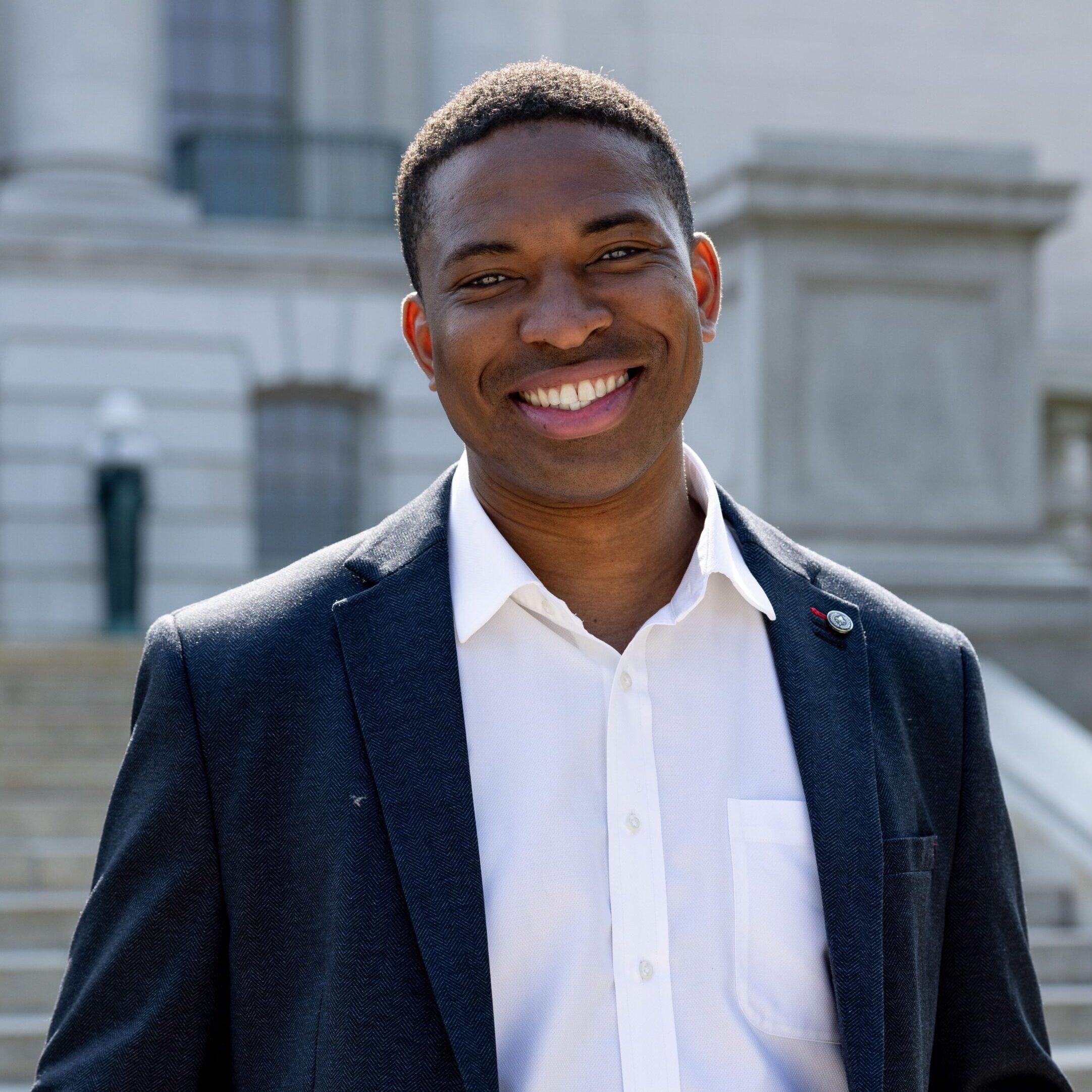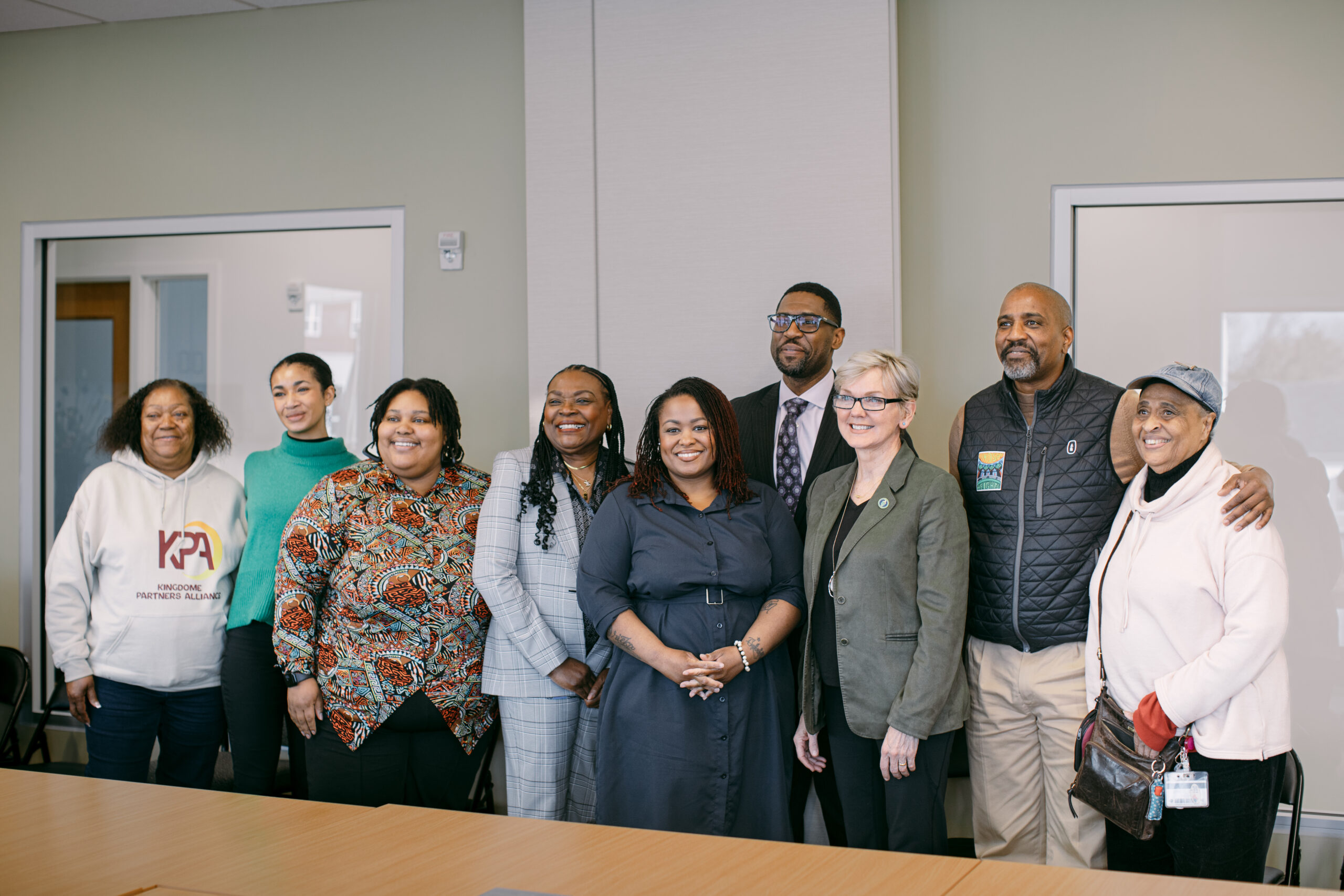
by Aisha Anderson | Mar 28, 2024 | Community, Events, Inflation Reduction Act
On Wednesday, March 27, Walnut Way welcomed the U.S. Department of Energy (DOE) Secretary Jennifer Granholm to their site, opening up a conversation about shared priorities in uplifting progress for environmental justice communities and the transformative nature of the DOE’s involvement in helping the country reach decarbonization goals.
“What a massive honor to host Jennifer Granholm to Walnut Way, having the opportunity to showcase the transformational work being done with community-led comprehensive development,” said Antonio Butts, Executive Director of Walnut Way. “Because of the work being done at the DOE, we can use these grants to further the development of our neighborhood and provide green energy opportunities for low to middle-income individuals, sustainably transforming the city one grant at a time.”

Photo Credit: Clean Economy Coalition of Wisconsin
“The Inflation Reduction Act (IRA) and the Bipartisan Infrastructure Law (BIL) are geared towards healing the rift of the past,” said Granholm. “We want to emphasize and empower communities to have a voice. This can be seen through grant stipulations such as the Community Benefits Agreement (CBA). With the CBA, we wanted to provide a vehicle to empower communities to speak and be heard.”
During her visit, Secretary Granholm participated in a roundtable facilitated by Butts. While leading the roundtable, Butts outlined Walnut Way’s work to elevate the voices of those in the community who haven’t previously had a seat a the table for environmental justice work and the community impact of helping weatherize and install renewable technology on homes in the neighborhood.
Granholm heard several concerns from Butts and others. In her response, she emphasized an upcoming IRA program to help low to moderate-income households with appliance rebates.
“But what we’re going to need is we’re going to need partners on the ground to be able to get the word out to people so they know that these are going to exist,” Granholm said. “Now, it comes through the state and Wisconsin has pledged to by June to roll out their program.”
Granholm shared that the program, for example, might be able to help people replace a worn-out furnace or air conditioning unit with a more expensive heat pump — a more efficient device that transfers energy instead of mostly producing it with fossil fuels.
Butts said the conversation was productive and noted that initiatives from the DOE and programs implemented through the IRA are key in accelerating clean energy solutions — specifically for low and moderate-income people.
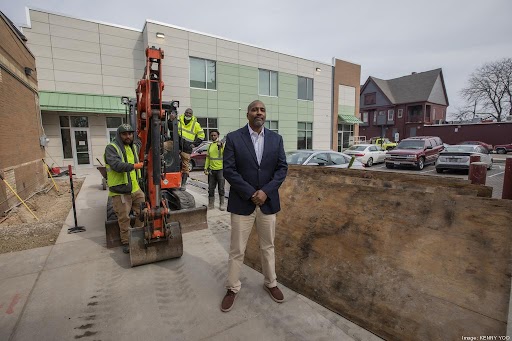
by Aisha Anderson | Feb 26, 2024 | Community, Community Change Grant, Inflation Reduction Act
Photo Credit: Walnut Way
Walnut Way, Community Change Grants and how their benefits can be leveraged to reduce environmental disparities in Milwaukee’s Northside
Clean energy dollars are reaching Milwaukee’s most underserved communities thanks to federal funding through the Inflation Reduction Act (IRA). With over 20 years of experience as an environmental nonprofit in Milwaukee’s northwest side, Walnut Way Conservation Corp. has established itself as a trusted resource for Lindsay Heights residents and statewide organizations through its commitment to creating healthier, safer, and more prosperous communities.
One of the ways this will be done is by the creation of a one-megawatt microgrid within the Lindsay Heights community. This will support the integration of clean energy into the electricity grid and protect grid reliability.
These place-based investments will be focused on initiatives led by the community members of Lindsay Heights, ensuring they are responsive to the community. They are designed to deliver on the transformative potential of IRA for communities most adversely and disproportionately impacted by climate change, legacy pollution, and historical disinvestments.
Antonio Butts, executive director of Walnut Way, said, “Over the past two years, significant work has been done in Milwaukee to address energy burden, energy affordability, and sustainability projects in underserved communities. This work has involved engagement in utility rate cases with the Public Service Commission of Wisconsin, cross-sector collaborations with local grassroots organizations, and partnerships with various state agencies.”
Through the EPA’s new Environmental and Climate Justice Community Change Grants, Walnut Way has the opportunity to move forward with its multi-million dollar proposal intended to advance sustainable change. The Community Change Grants, which were developed as a comprehensive response to pressing environmental concerns, leverage the collective strength of Walnut Way and its partner organizations by deploying a budget of approximately $20 million to be distributed over 36 months. Walnut Way’s proposal is specific to Milwaukee’s Lindsay Heights Neighborhood with the goal of increasing education, capacity building, governance participation, and environmental stewardship. The goal is to reduce the energy burden within the community and promote renewable energy sources among residents.
Overall, the project aims for a holistic transformation of urban infrastructure and the creation of a sustainable, equitable community.
Community Impacts: Direct Financial Assistance, Energy Independence, and Home Weatherization
“This grant opportunity is designed to fund community-driven projects that address environmental and climate challenges and enhance meaningful involvement in government processes related to environmental justice,” said Butts.
For Walnut Way, this starts with direct financial assistance to Lindsay Heights residents. The budget for the proposal outlines $3 million in direct assistance over three years to alleviate financial burdens associated with the cost of food, medical supplies, energy-efficient appliances, and utility bills.
Walnut Way has budgeted an additional $2 million to extensively weatherize 300 homes in the community. Weatherization services include upgrading appliances such as stoves and refrigerators to more energy-efficient models, installing heat pumps, and updating roofing in preparation for solar panel installation.
More notably, the initiative has allocated $1.5 million to implement a 0.5 MW microgrid for subscription-based renewable energy access. This project has been created to mitigate the high electricity bills and disconnection performed by the local utility company and will be done in partnership with Watts Up Way, an apprenticeship program born out of Walnut Way to support a clean energy transition, enhance energy independence within the community, and promote clean energy jobs.
To reduce the energy burden of residents, Walnut Way has budgeted $2 million to weatherize 300 homes in the community.“Our goals are ambitious,” Butts said, “And in order to complete these goals, it’s going to take a collective effort. Our objective is to sustain our engagement and ensure that generations to come have a voice that directly impacts our well-being and quality of life.”
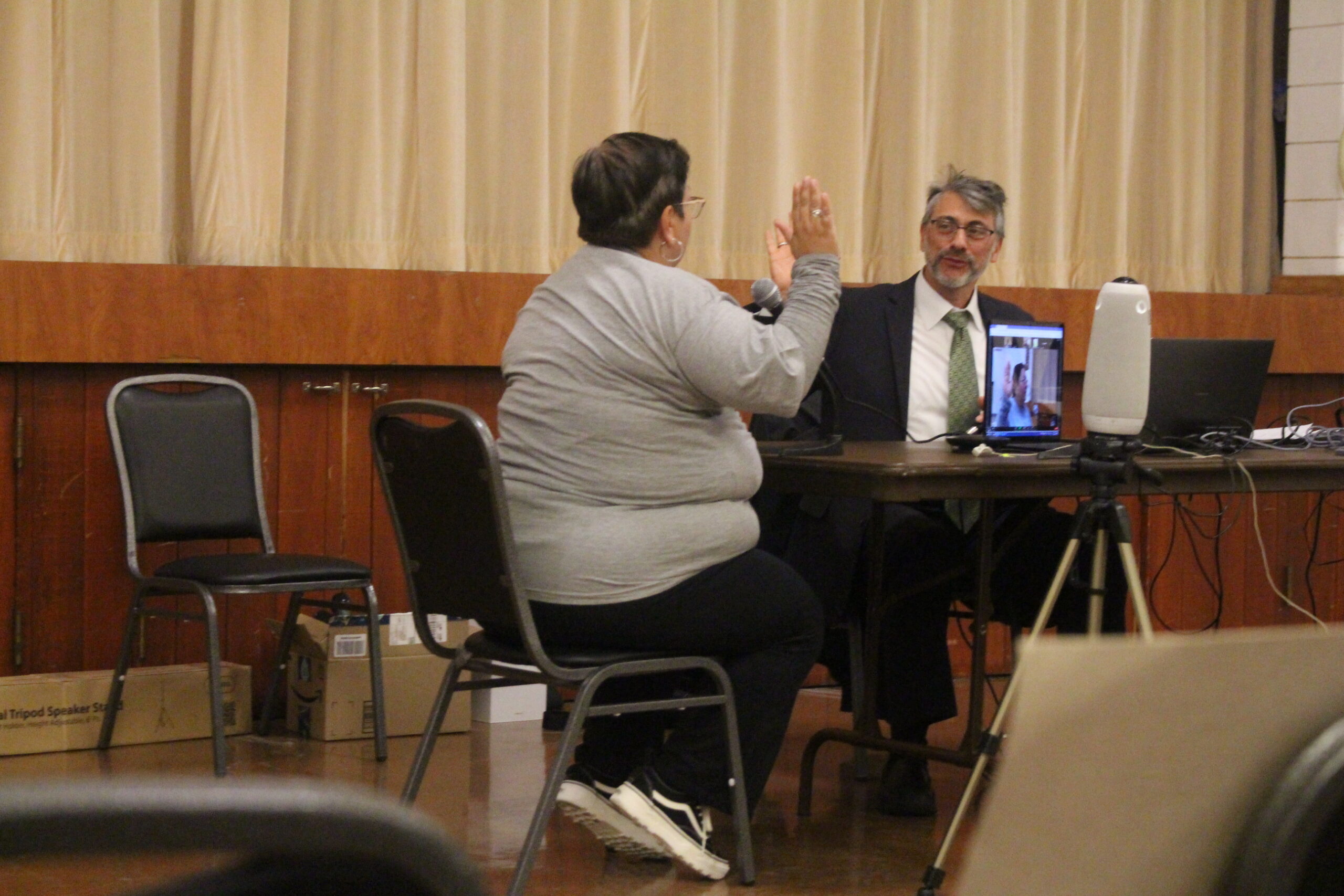
Photo Credit: Walnut Way
The Importance of Community-Led Transitions to Energy Justice
A critical element of this effort is the Resilient Resident Civic Engagement Compensation Program. This innovative program by Walnut Way provides a strategy for community members to gain recognition and compensation for their contribution to the project, providing a way to earn additional income and engage in civic activities.
The objective of this is to provide an avenue for transparent two-way communication, leadership, and adjustment between government entities and constituents to build trust within the community. For Walnut Way, community engagement has always been the foundation for achieving sustainable change. This is apparent in conversations among Walnut Way and Lindsay Height’s residents when asked about their vision for the community moving forward.
The desire for change among residents is not scarce, but the means to make improvements have been.
“The reality is that we need to take advantage of all available resources,” Butts admitted, and “especially listening to our community members. They live here. They know what they need to be successful.”
He continued, “Being held accountable by the residents requires us to be aligned, coordinated, and to already have established a baseline of accomplishments for us to earn their trust.”
“Working alongside residents enables us as an organization to respond with confidence to aid the community moving forward,” Butts said.
Emmonia Barnett, who has lived in Lindsay Heights for over ten years, shared, “My vision is a community that is empowered to look after itself.”
Her neighbor, Ammar Nsoromoa, echoed Barnett’s wishes and added, “I would like the community to be beautiful. You don’t see trash. You don’t see people in poverty. The community is self-sustained. We take care of one another. The businesses serve the locals. We feed each other with food from grocery stores in our neighborhood. We want to be actively a part of what’s going on.”
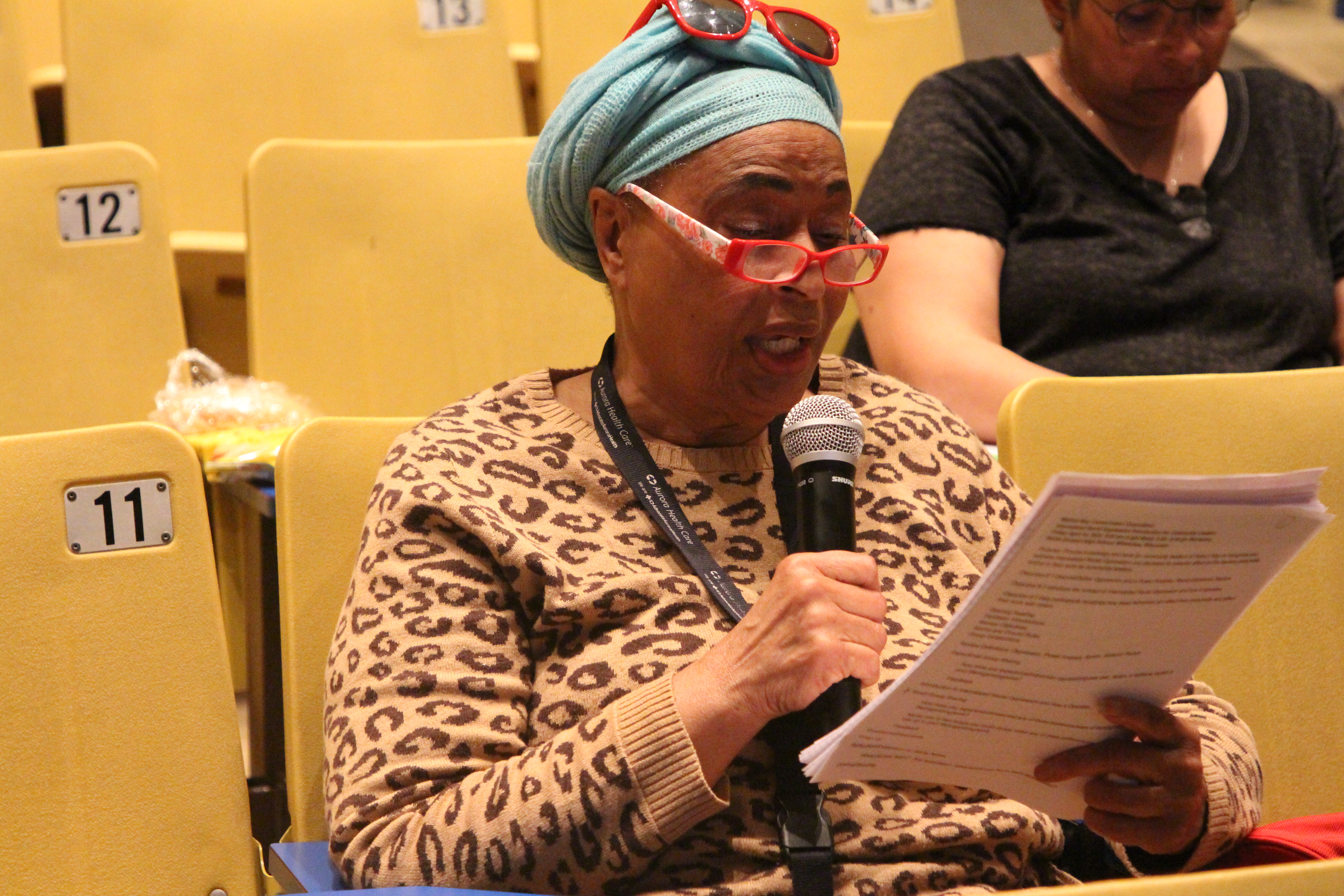
Photo Credit: Walnut Way
EPA Grant deadlines, technical support, and how to bring change to your community
While Walnut Way is still in the preliminary stages of the grant application, the Notice of Funding Opportunity is open now through November 21, 2024, with applications accepted on a rolling basis. Additional support for organizations and communities seeking technical assistance with grant eligibility and technical writing will be provided through the EPA’s Environmental Justice (EJ) Thriving Communities Technical Assistance Centers (TCTAC). The creation of these centers was a direct response to feedback from overburdened communities and organizational leaders who have encountered barriers to maximizing the full benefits of available federal funds.
There are the two TCTACS serving Region 5 organizations and communities that have been disproportionately impacted by environmental hazards. As designated by the EPA, Region 5 spans 35 tribal lands and six states–Illinois, Indiana, Michigan, Minnesota, Ohio, and Wisconsin. The Great Lakes, led by the University of Minnesota, and Blacks in Green (BIG) Justice, led by a partnership of community-based organizations in Illinois, are the two TCTACs that serve Region 5. Interested applicants can submit an intake form detailing their needs to either center to get help with overcoming barriers to accessing funding from the Community Change Grants.
“Our objective is to sustain our engagement and ensure that generations to come have a voice that directly impacts our well-being and quality of life,” Butts said.
He also noted that the Community Change Grants program has the capacity to expedite this process for the residents of Lindsay Heights while allowing the community to lead in its own solution development towards the clean energy transition.
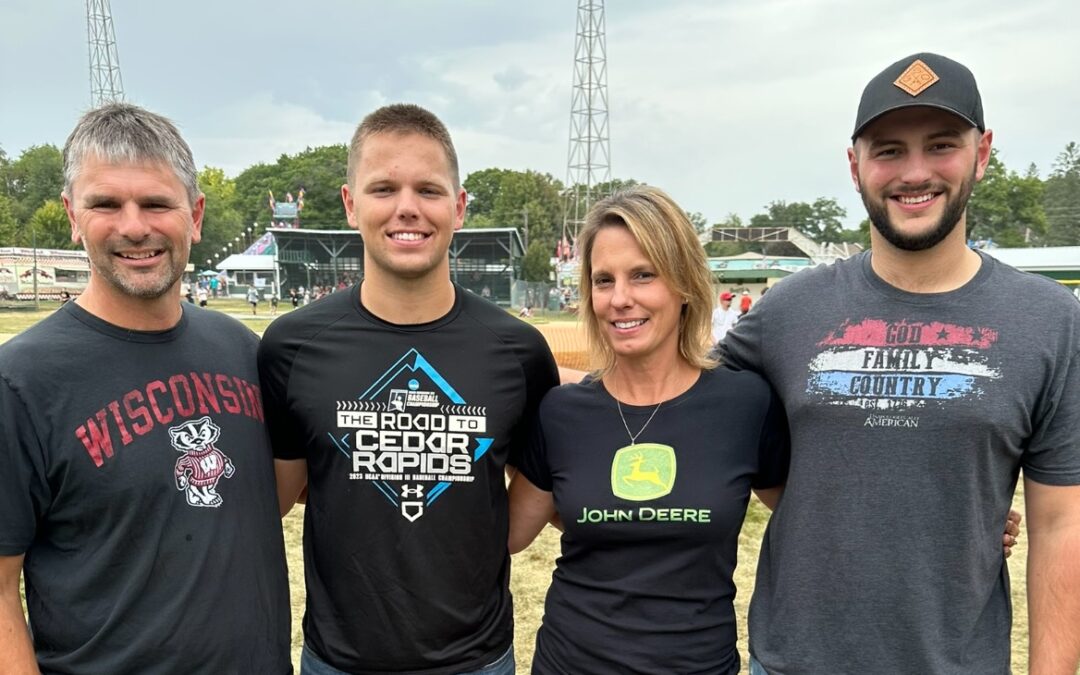
by Aisha Anderson | Feb 9, 2024 | Inflation Reduction Act, REAP, Solar, Sustainable Business, Sustainable Businesses
Photo Credit: Brett Carlson – Owner and Founder of Ag & Business Solar Partners
In 2020, Brett Carlson and his dad, Carl, decided to install solar panels on the farm using the financial support offered through the Rural Energy for America Program (REAP). The complexities of this process inspired the creation of his company, Solar and Ag Business, whose goal is to help farmers and small businesses reap the benefits of solar energy.
The Rural Energy for America Program (REAP) is a federal program that provides financial assistance to agricultural producers and rural small businesses to make the switch to renewable energy. The REAP Grant was established in 2002, and up until 2023, the grant covered 25% of the total project costs. The grant was expanded to cover 40% of the total project cost in early 2023 and then increased to 50% of total project costs thanks to additional funding from the Inflation Reduction Act (IRA). When you factor in tax credits and depreciation, Wisconsin farmers and small businesses can install solar at a fraction of the cost.
Solar energy can reduce energy bills, benefitting the bottom lines for farms and rural small businesses that are often looking for additional efficiencies to help keep their businesses viable.
“Of the many volatile expenses that come with farming, this is one that we can control. The initial overhead cost of installing solar was a barrier that most farmers weren’t able to overcome until now,” Brett said.
The benefits of the REAP Grant to rural America are significant, but the lack of education about solar in rural areas and the complexities of the REAP grant application itself presents a challenge. Brett experienced this firsthand when he helped his parents apply for the REAP grant. Brett explained that he and his parents left that experience feeling frustrated as they were pushed to outsource help for the REAP application to “predatory consultants and grant writers,” who knew that most farmers could not navigate grant jargon on their own.
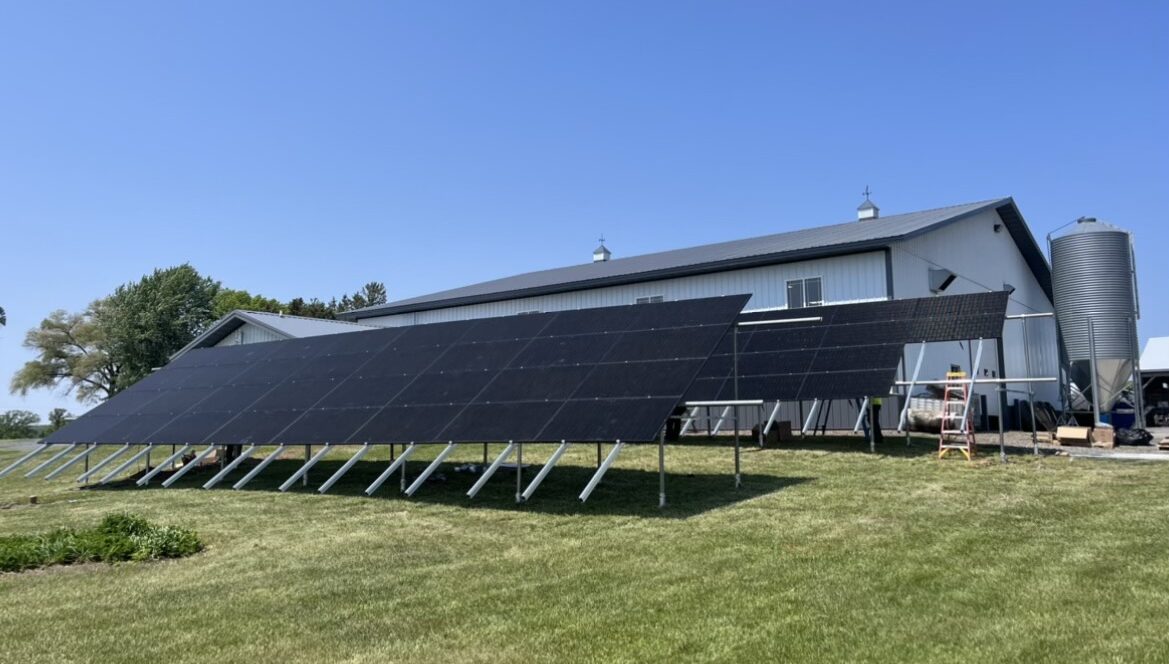
AG and Solar Partners grew from that frustration, and now Brett helps navigate federal incentives and tax benefits and connect farmers and small business owners to trustworthy clean energy businesses. One of Brett’s clients, Dan Tronrud, is an auto shop owner in Wolf River. Dan praises Brett’s passion for making solar energy accessible to his community.
When asked about his experience with applying for the REAP Grant, Dan exclaimed, “He’s excited, and he gets me excited. He knows everything about solar and electricity and is so good at breaking it down. There are no questions left unanswered.”
With the help of Ag and Business Solar, Dan was able to submit his application for the December 2023 grant cycle and hopes to bring solar panels to his shop.
Brett’s background of growing up on his family farm and then going on to study business and entrepreneurship offers him a unique skill set that empowers him to navigate complex conversations with business partners, consultants, and farmers around the intricacies of implementing solar energy on a commercial scale while taking advantage of federal incentive tax benefits.
“As a business owner, the transition to solar makes total sense,” Brett said. “Politics aside, look at the numbers, they work. The math makes sense. It’s a no-brainer with the REAP grant and tax incentives.”
The benefits of transitioning to solar energy as a business decision are clear, immediate, and accessible with the help of the REAP Grant and IRA incentives.
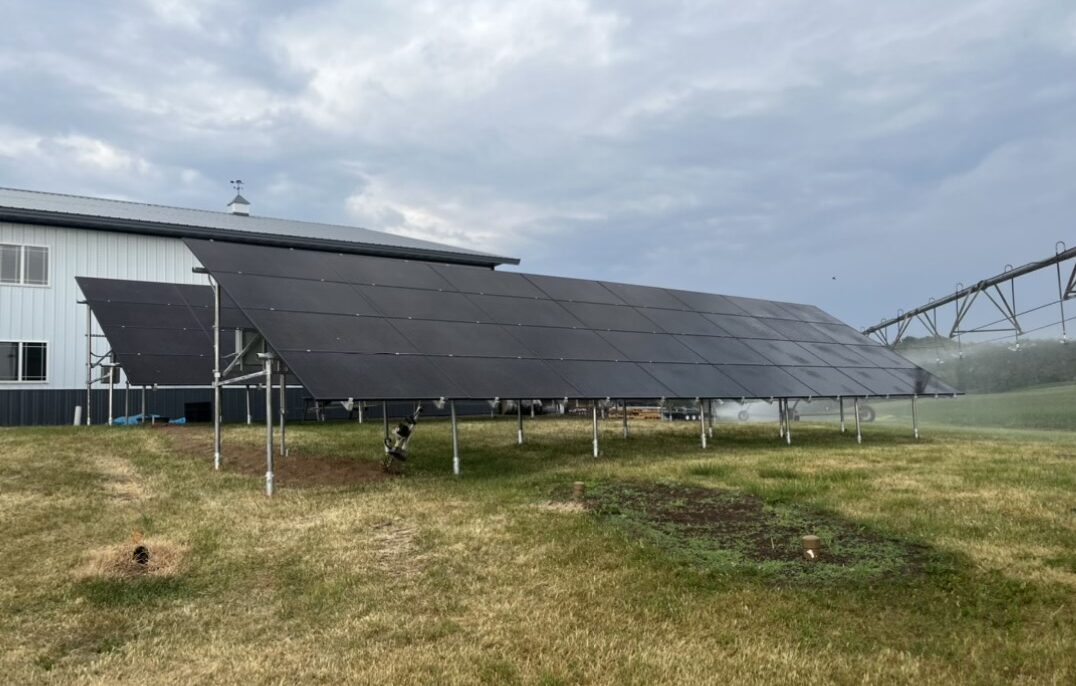
“Each generation did something innovative—something that no one else was doing,” Brett said. “My dad was way ahead of his time, he put up wind turbines, the first one in our town.”
He and his parents see solar as a partial solution to the deteriorating electricity grids in rural areas.
“It’s aging, expensive to maintain, and it’s not fair that there are no other options provided by utility companies,” Brett said. “Transitioning to solar is a way for us to have agency to protect ourselves from outdated grids. I want people to recognize how this technology benefits us. I grew up in this community, and I will spend the rest of my life here. I don’t want to keep watching my loved ones and the people that I grew up with struggle to stay in business if there is something that can be done to help. That’s why I’m doing this. I want this community to not only stick around but to thrive.”
Because of the success of past clean energy projects with the REAP grant, it will be continuously funded through the IRA with $2 billion spread throughout a ten-year span. Farmers and small business owners interested in applying for the REAP grant should send their application materials to their local Rural Development State Energy Coordinator or contact Brett. Deadlines for the 2024 grant cycles are March 31, June 30, and September 30. Funding guidelines are state and project-specific, which is where Brett’s expertise at AG and Business Partners can be useful. Brett offers free consultations for small businesses, residential properties, and farms throughout rural Wisconsin.
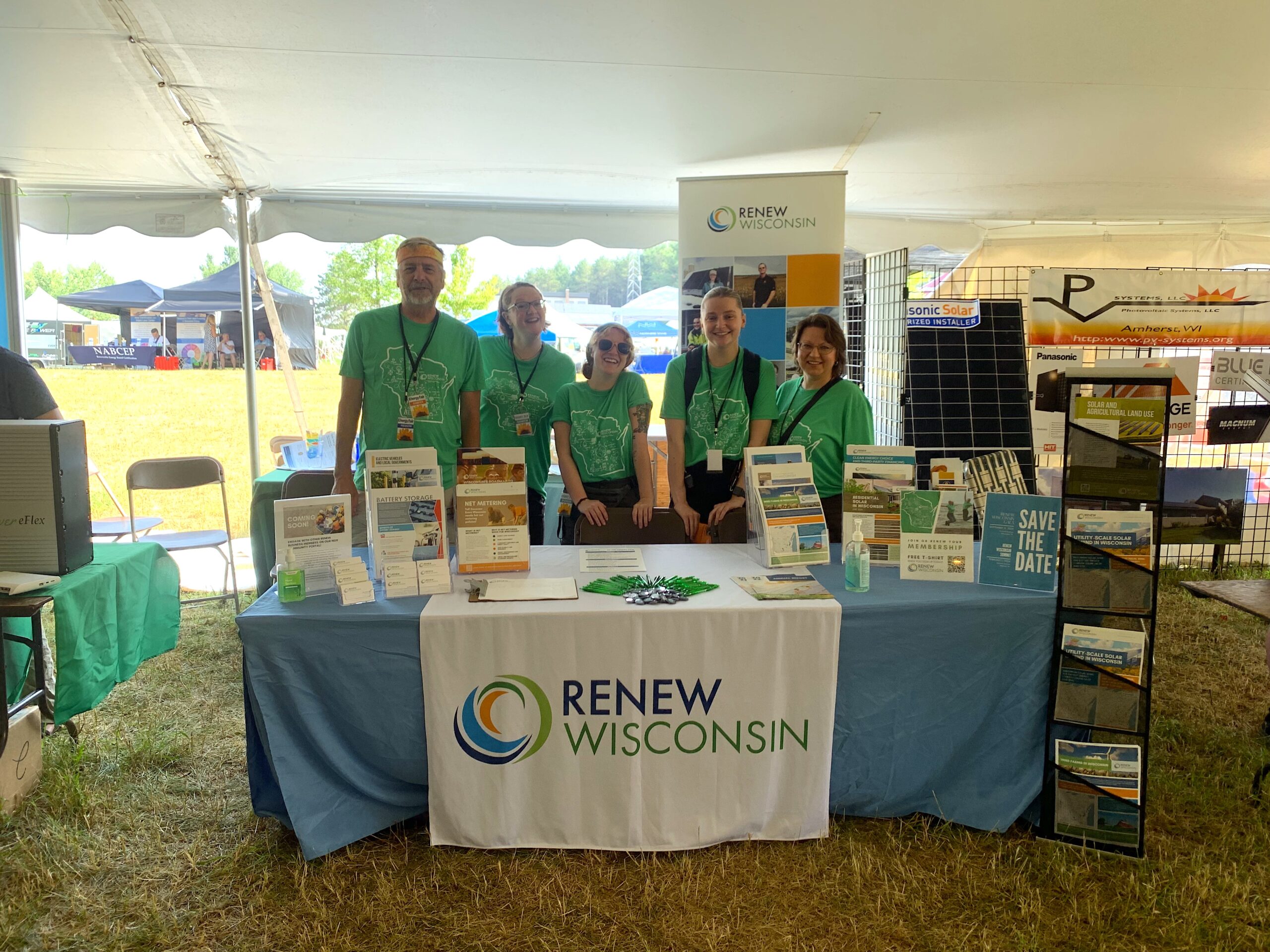
by Julia Holzschuh | Jun 27, 2023 | Electric Vehicles, Electrification, Energy Storage, Events, Inflation Reduction Act, Local Government, Netzero Wisconsin, Policy, Programs, RENEW Wisconsin, Renewables, Solar, Solar for Good, Sustainability, Utility Scale
Last weekend, the Midwest Renewable Energy Association (MREA) hosted the 32nd Annual Energy Fair, bringing people together to learn about sustainability and clean energy, connect with others, and take action toward a sustainable future. The Fair featured workshops, exhibitors, live music, inspiring keynote speakers, family fun, great local food, and more.
RENEW staff presented some compelling workshops and you can download slides from their presentations below.
Zero Carbon by 2050—A Path for Wisconsin
Andrew Kell, RENEW Policy Director, discussed zero-carbon goals and ongoing planning efforts in Wisconsin. Andrew also was a guest on a live podcast, focused on Wisconsin’s Net Zero future.
MadiSUN Workforce Training
Lauren Cohen, RENEW Program Coordinator, held a workshop regarding career growth opportunities within Wisconsin’s clean energy industry, focusing primarily on opportunities within the solar industry.
Vehicle-to-Grid: Opportunities and Challenges
Francisco Sayu, RENEW Emerging Technology Director, discussed how Vehicle-to-Grid technology unlocks the energy stored in electric vehicles and opens opportunities for energy trading, energy management, and grid resiliency.
Farming Sunshine: Solar and Ag Land Use
Nolan Stumpf, one of RENEW’s Interns, presented a session regarding solar farms and the opportunities and challenges of using the land for farming purposes and advancing clean energy.
Can Clean Energy Overcome Local Opposition?
Michael Vickerman, RENEW Clean Energy Deployment Manager, discussed the opposition clean energy faces at the local level and how to overcome those barriers.
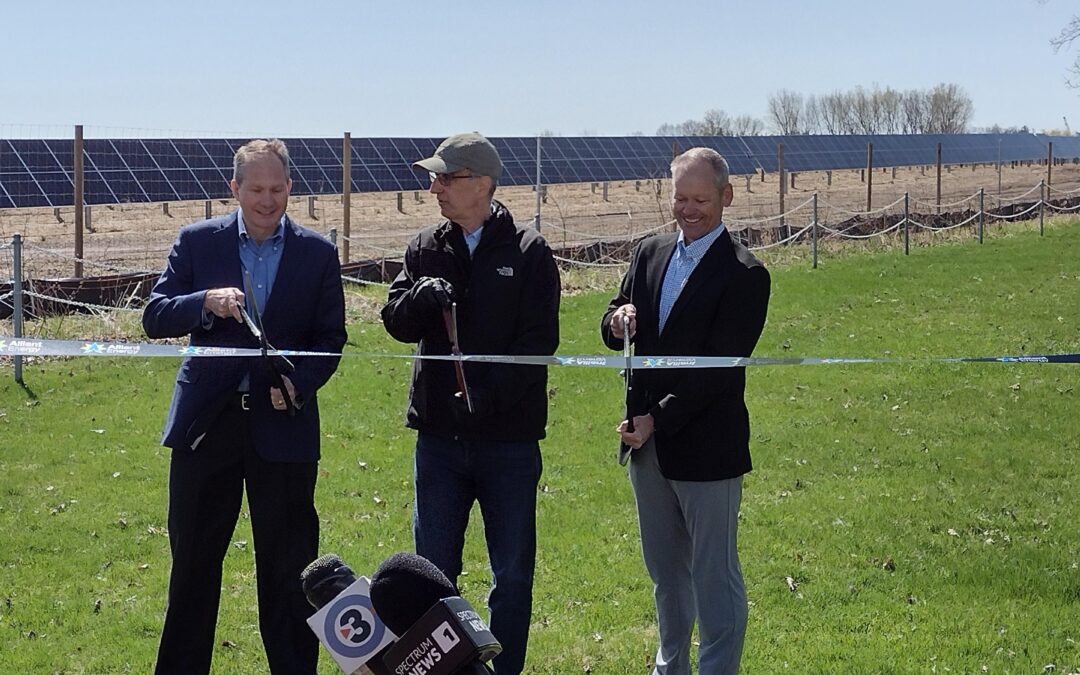
by Heather Allen | May 26, 2023 | Inflation Reduction Act, Netzero Wisconsin, Solar
On April 18, 2023, RENEW Wisconsin joined County Executive Joe Parisi, Alliant Energy, SunVest Solar, and other community representatives at the newly constructed Yahara Solar Project to celebrate Earth Week. With the completion of the 90-acre solar project, Dane County has become the 4th County in the United States to power all of its county facilities with 100% renewable electricity.
The Yahara Solar Project is a crowning achievement and an innovative approach to developing clean energy. It will initially be owned and operated by the developer, SunVest. Alliant will deliver the power generated to its customers, and Dane County will receive renewable energy credits (RECs) in return for leasing the land. After seven years, the Yahara Solar Project will be sold to Alliant Energy to become part of the utility’s clean energy generation resources. Pieper Electric was the installation contractor and worked with multiple local unions.
County Executive Joe Parisi and Dane County have demonstrated remarkable climate and clean energy leadership. Since 2011, the County has built cutting-edge technology to power heavy-duty equipment like snow plows and garbage trucks. In addition, Dane County also established an Office of Climate and Clean Energy in 2017. Over time, Dane County has built solar projects at the airport, campsites, and other county facilities. In 2020, Dane County released the Climate Action Plan: Today’s Opportunity for a Better Tomorrow which included a path to deep decarbonization.
Dane County’s efforts to demonstrate practical solutions to reducing energy bills and emissions are a model for the nation. Now Dane County is working to share that knowledge with residents. Check out the most recent podcast from Dane County Executive Joe Parisi, Kathy Kuntz (Director of the Office of Climate and Clean Energy), and me, Heather Allen (Policy Advisor for RENEW Wisconsin). This podcast discusses how the Inflation Reduction Act (IRA) makes it easy to save money and shift to clean, renewable energy.
Learn How You Can Benefit from the IRA:
• The Dane County Office of Climate and Clean Energy
• Rewiring America’s calculator to help identify which tax credits and up-front discounts you can utilize.
• MadiSUNsolar.com for Dane County residents interested in going solar.
• RENEW Wisconsin’s programs help nonprofits go solar and purchase electric vehicles.
• RENEW’s summary of the Inflation Reduction Act and clean energy resources.
Podcast Links:
• Video
• Audio
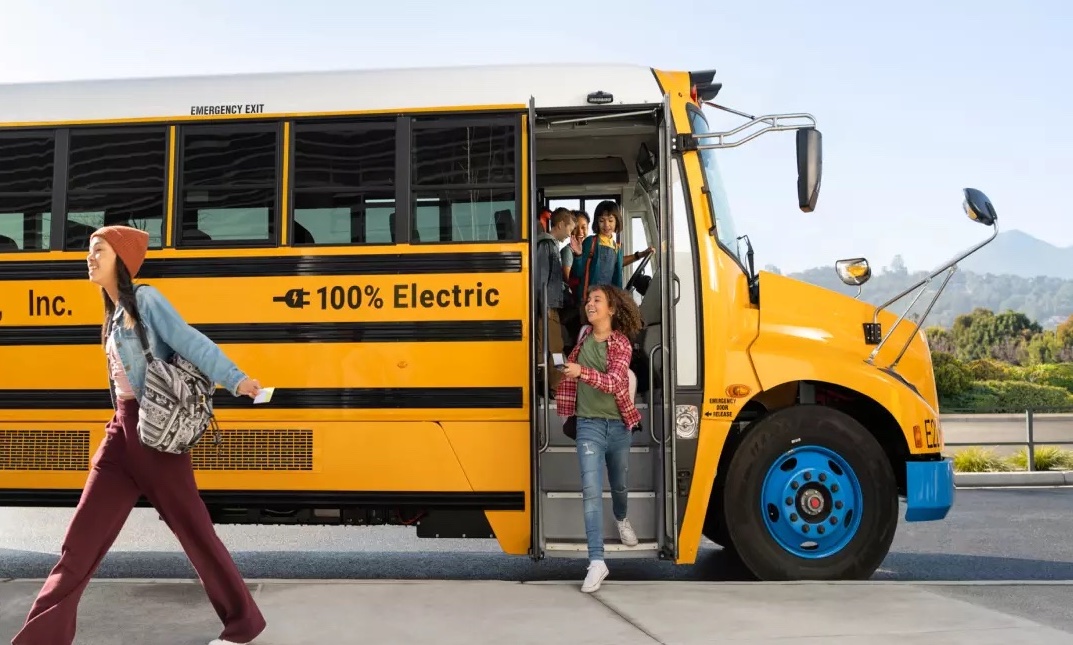
by Francisco Sayu | Apr 27, 2023 | Electric Vehicles, Electrification, Inflation Reduction Act
The Environmental Protection Agency (EPA) just announced a new round of competitive funding through the Clean School Bus (CSB) Grants Program. This is the second funding opportunity for clean school buses from the Infrastructure Investment and Jobs Act (IIJA). Unlike the 2022 Clean School Bus Rebates, this new funding opportunity is competitive – instead of a lottery. We encourage school districts to partner with other communities, transportation providers, and electric utilities for their application. Any eligible school district or third-party applicant must be set up on grants.gov and SAM.gov. Interested parties should confirm they are registered and current on both websites as soon as possible.
Why Electric School Buses?
Cost savings: electric buses get the equivalent of 17 miles per gallon (MPG) compared to 6 MPG for diesel buses; these savings can amount to more than $170,000 across the bus lifecycle.
Health benefits: electric school buses cut diesel emissions, benefiting communities burdened by air pollution and high childhood asthma rates.
Energy security and independence: electric buses can run on locally sourced renewable energy from a nearby solar or wind farm, which helps the local economy.
Electric buses have operated safely and reliably in many parts of the United States, including Michigan, Minnesota, and Alaska. Although electric buses are cheaper to own and operate than traditional diesel buses, the initial cost of new buses has been a barrier to adoption, and only a few schools have been able to afford them. The Clean School Bus (CSB) Grants Program is solving this problem by covering up to 100% of the cost of new buses so that schools can save money without a significant out-of-pocket expense. Sounds too good to be true? Check out this blog post to find the list of school districts that already received awards for new electric buses in Wisconsin.
2023 Clean School Bus (CSB) Grants Program Overview
The EPA is awarding approximately $400 million in competitive grants under the Clean School Bus (CSB) Grants Program. The grant application will allow for a minimum of 15 buses and up to 50 buses for school district applicants and for a minimum of 50 and up to 100 buses for third-party applicants serving at least four school districts. Awardees will receive up to $395,000 per bus without cost-sharing or matching requirements. Applications must be submitted electronically to EPA through grants.gov by Tuesday, August 22, 2023, at 11:59 p.m. (ET).
Eligible applicants include the following entities:
- Local or State governmental entities providing school bus service to one or more public school systems
- Indian Tribes, Tribal organizations, and tribally controlled schools providing school bus service to one or more Bureau-funded schools
- Nonprofit school transportation associations
- Public charter school districts responsible for the purchase, lease, license, or contract for the service of school buses for that charter school
- Eligible contractors
Please refer to the grant Notice of Funding Opportunity (NOFO) for specific information about this
competition.
Important Dates
| Activity |
Date |
| Information Sessions |
The first Information Session will be on Wednesday, May 10, 2023, at 3:00 p.m. (ET). Click here to register. |
| Deadline for Submitting Questions |
Wednesday, August 9, 2023, at 11:59 p.m. (ET) |
| NOFO Closes – Application Deadline |
Tuesday, August 22, 2023, at 11:59 p.m. (ET) |
| Anticipated Notification of Selection |
November 2023 to January 2024 |
| Anticipated Awards |
February to March 2024 |
Schools can submit questions to cleanschoolbus@epa.gov. Please type “Clean School Bus NOFO Question” in the subject line of your email. The deadline for submitting questions via email is Wednesday, August 9, 2023, at 11:59 p.m. (ET). Schools may also contact Francisco Sayu, Emerging Technologies Director RENEW Wisconsin, at francisco@renewwisconsin.org, for general help with this grant application.












